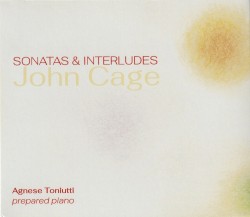 John Cage – Sonatas & Interludes
John Cage – Sonatas & Interludes
Agnese Toniutti
Neuma 172 (neumarecords.org)
On first hearing John Cage’s prepared piano, his close friend and colleague Lou Harrison is reputed to have exclaimed, “Oh dammit, I wish I’d thought of that!” With his invention Cage had created an instrument that opened the door to a new piano sound world via temporarily altering – preparing – some of the strings by strategically placing bolts, screws, rubber erasers or other objects between them. This gives each prepared string its own characteristic timbre and sound envelope, dramatically contrasting with those left unprepared.
While Bacchanale (1938-1940) was Cage’s first prepared piano composition, it took him another decade to pen his definitive work for it: the hour-long 19-movement Sonatas and Interludes (1946–48). Long viewed by the music establishment as a gimmicky outsider work, it’s become repertoire that new music pianists must reckon with.
Italian Agnese Toniutti’s admirably sensitive Neuma Records rendition privileges rhythmic precision, a relaxed mood, in addition to a nuanced preparation of the grand piano. This produces a delightfully delicate and rich palette of dynamics, timbres and textures. I particularly enjoyed her effective evocation of a distant bass drum, buzzy gongs and the uncanny aural illusion of the sounds of a bonang and saron (respectively a gongchime and a metalophone instrument in the Javanese gamelan), interleaved with ordinary piano sounds.
There are certainly more dramatic and propulsive recorded performances of Sonatas & Interludes, such as those by (my teacher) James Tenney, Margaret Leng Tan, John Tilbury, Yuji Takahashi and others. On this album however, Toniutti makes a compelling case for a sensitive, soft-grained, quiet-leaning performance which I savoured. I think Cage would have too.



